
Vol. 7, No. 10, October 2011 |
 Printer-Friendly PDF Version Printer-Friendly PDF Version |
FL SARC Course Announcement
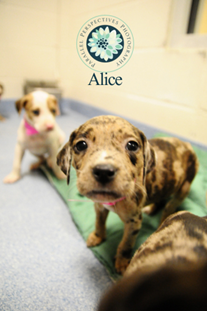
"Alice," a Catahoula Leopard Dog available for adoption at the Animal Adoption & Resource Center (JHS) Joplin, Missouri. (Photo: Parallel Perspectives)
Title: Awareness Level – Small Animal Emergency Sheltering
Date: 9:00 a.m. - 7:00 p.m. Saturday November 5
Place: Okaloosa County Annex, 127 NW Hollywood Blvd., Fort Walton Beach
Cost: Free
Host: Animal Services at PAWS (Panhandle Animal Welfare Society)
Information/Registration: http://www.flsarc.org/Training.html (Download and complete the form: email it to the address included on the form or fax it to (727) 596-2555.
A Free one-day course that includes classroom presentations and hands-on exercises. Space is limited to 35 participants. Register early to secure your place!
Please pass this announcement to others who want to be involved helping animals in Florida. This course is required to respond with the Florida State Animal Response Coalition. Go to www.flsarc.org for more information about our team.
A NOTE FROM SARC: This class is presented free to participants, but costs are incurred for each participant. For example, printing and supplies for students are incurred weeks before class and are not recoverable.
The funding that allows us to present this course is difficult to obtain; so if you register to attend, please honor your commitment. We realize that emergencies arise that might prevent you from attending. If this happens, please let us know right away. This will allow us time to fill your spot and make the best use of our funding.
Also from SARC’s Pam Burns: Training opportunities are available for animal responders through The International Wildlife Rehabilitation Council (IWRC: http://theiwrc.org/). The IWRC Symposium in Ft. Lauderdale is November 9-12. An interesting article, “Seven Things to Know About How Hurricanes Affect Wildlife” by Kevin Coyle is available through their site at http://nwf.visibli.com/share/nRAQw2. |
 |
[top]
Training Through FDACS and IFAS at Indian River
The Florida Department of Agriculture and Consumer Services is collaborating with the Western Institute for Food Safety and Security of UC Davis University of California and the Regional Domestic Security Task Forces to offer this series of Department of Homeland Security (DHS) certified agroterrorism awareness courses in Florida.The courses are open to all United States Citizens, and are free of charge (lunch not provided) through DHS grant funding.
All training will be conducted at the Indian River Research and Education Center, 2199 South Rock Road, Fort Pierce, FL 34945.
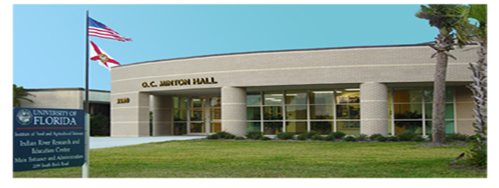
The UF Indian River Research and Education Center, or IRREC in Fort Pierce, is one of the 13 IFAS research and education centers. Research began on the site in 1947 with only one scientist and a small laboratory. (For more information http://www.irrec.ifas.ufl.edu/.)
Thursday, November 17 – AWR 151 Understanding the Dangers of Agroterrorism: Registration at 12:00 pm; Workshop from 12:30 pm to 5:00 pm.
Friday, November 18 – AWR 152 Principles of Preparedness for Agroterrorism and Food Systems’ Disasters: Registration at 7:30 am; Workshop from 8:00 am to 4:00 pm.
Thursday, December 15 – AWR 153 Principles of Detection and Diagnosis – Strategies and Technologies: Registration at 7:30 am; Workshop from 8:00 am to 4:00 pm.
Friday, December 16 – AWR 154 Principles of National Incident Management Systems (NIMS) and Risk Communication: Registration at 7:30 am; Workshop from 8:00 am to 4:00 pm.
Thursday, February 9 – AWR 155 Principles of Frontline Response to Agroterrorism and Food Systems’ Disasters: Registration at 7:30 am; Workshop from 8:00 am to 4:00 pm.
Friday, February 10 – AWR 156 Principles of Planning and Implementing Recovery: Registration at 7:30 am; Workshop from 8:00 am to 4:00 pm.
To find additional information about each course and to register on-site please visit http://dhs.wifss.ucdavis.edu/agroterrorism/classes/classesbydate.php.
If you have any questions please contact John Burkette at (850) 245-1387 or email John.Burkette@freshfromflorida.com.
[top]
Project RECOVER
Exceptional vet student develops database software
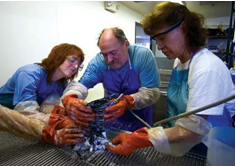
Kendra Stauffer, DVM, Area Emergency Coordinator for USDA/APHIS-VS passed along a story about a new animal tracking system developed by Jonathan Lustgarten. Lustgarten’s education was in computational biology and bio-organic chemistry; then bioinformatics and biomedical informatics. Having earned his PhD he’s now a third-year veterinary student at the University of Pennsylvania.
Lustgarten has combined his interests into a program that can help veterinarians better handle record-keeping in the field, especially during disaster-response situations. His program is called the Relief and Emergency Computerized Veterinary Records or RECOVER system. It is a computer software program that centralizes data and allows veterinarians to efficiently record and then observe findings.
RECOVER is an Internet-based medical record platform. Thus, using the appropriate software, users can recover information with a hand-held device or computer anywhere in the world. The system standardizes and simplifies forms, and eliminates filing and caring for thousands of post-emergency paper documents, an almost impossible task in a crisis situation.
Lustgarten believes his program – initially developed for wild animal tracking – can be used in many scenarios. Tracking a virus, for example, by inputting information anywhere in the world and having it available via the Internet to researchers or physicians anywhere. Information can be recorded and studied in real time to give a fast picture of what's happening on the ground. Tri-State Bird Rescue www.tristatebird.org agreed to try out the system first, before it is widely released.
Kendra Stauffer, DVM, DACVPM
Area Emergency Coordinator
USDA/APHIS/Veterinary Services
(352) 313-3083 office
[top]
Listeria Outbreak Takes 21 Lives
CDC Expects More Cases in October

Listeria, the culprit in an outbreak linked to cantaloupe that has to date (10-07) killed 21 people in 18 states, is a severe food-borne infection. According to a recent story in "USA Today," melons have been implicated in at least 36 food-borne infection outbreaks in the last 21 years. This one is the first attributed to listeria, but the bacteria kill nearly a third of victims.
No one yet knows the “root cause” of the deadly cantaloupe Listeria outbreak. As of October 7th, 21 people have died in the U.S. The infected cantaloupes came from a single Colorado producer, Jensen Farms, which has moved 1.5 million of its “Rocky Ford” cantaloupes to market.
About Listeria
“Listeria is a rare but deadly disease,” said Dr. Thomas R. Frieden, director of the Centers for Disease Control and Prevention (CDC). Because the Listeria bacteria that cause infection can have a relatively long incubation period, the CDC expects the number of cases and the fatalities to rise in October.
According to Frieden, “Listeria is an unusual bacteria in a couple of ways. One is the incubation time, the time between consumption of an infected product and the onset of illness. Listeria takes longer than many bacteria, from one to three weeks – even a couple of months. So people who ate the cantaloupe some time ago may still get sick in the coming weeks.
“Listeria flourishes even in the cold. So unlike most other bacteria, if you got a contaminated cantaloupe in your refrigerator, the Listeria in the cantaloupe will continue to grow. That’s unlike Salmonella or other bacterial infections, and it’s one of the reasons that we unfortunately may see a continued number of cases from cantaloupe that are already in people’s refrigerator.”
And what about response?
“We’ll look for any potential animal intrusion onto the farm,” says Dr. Sherri McGarry, senior advisor to FDA’s office of foods, who also listed: water quality, growing and harvesting practices. “We’ll also look at process within the facility for packing and potentially rinsing the cantaloupes themselves – how they were stored and whether there’s amplification in that process. So we’ll be looking at different factors from the environmental perspective to see how this contamination may have occurred, how it could have been spread.
“Then, most importantly, we’re going to take lesson learned, share that with our partners and industries, CDC and the states, to prevent this from happening in the future. Our goal is to prevent future outbreaks.”
Cantaloupe in Florida The melon referred to as cantaloupe is actually named muskmelon (Cucumis melo, var. reticulatus). The term “cantaloupe” is something of a misnomer. |
[top]
Make Hurricane Shelters Pet Friendly
A letter to the editor Miami Herald, September 5, 2011 – by Ron Magill, zoo communications/media relations director, Zoo Miami (www.miamimetrozoo.com)
I was forced to ride out Hurricane Irene in midtown Manhattan after airports were closed and flights were cancelled. In preparation for this mammoth storm, the country’s largest city implemented precedent-setting mass evacuations and, for the first time ever, shut down its entire mass-transit system.
Having ridden out several storms such as Andrew and Wilma, I found it ironic that I was now stranded in New York City because of another potentially catastrophic storm headed for an area that isn’t used to these types of events.
Though I saw some things that indicated a lack of storm experience, I was impressed with how smoothly everything went and how well the people of New York cooperated.
What impressed me most was how the majority of shelters allowed people to bring their pets with them. Mayor Michael Bloomberg made it clear that he understood that people’s pets were part of their family, and that many people would risk their lives and stay in an evacuation zone if fleeing meant that they had to leave their pets. His administration made a concerted effort to ensure that this didn’t happen.
This is contrary to what I see in South Florida, where most shelters don’t allow pets. Though there has been some progress made, we’re still far from where New York is. Living in a region that’s so prone to hurricanes means that we should be the role model when it comes to providing pet-friendly shelters. I understand that some people are uncomfortable around animals; however, I’m sure there’s a way that shelters can be coordinated so that the two populations can be separated and still function.
Our pets are not only part of our families; they provide a sense of calm and reassurance that’s needed during trying times. I strongly urge South Florida leaders to lift the pet ban on the majority of our emergency shelters. No one has ever died from a pet in an evacuation shelter, but people may have already died because they couldn’t bring their pets to one.
SART Editors: Please feel free to use my letter! Thank you for what you do and helping to get the word out. I received a call from Emergency Management here in Miami-Dade right after the letter was published promising me that no one with a pet will ever be turned away from a shelter. I suggested to them that they get that message out as best they can as most pet owners that I know of are not aware of that policy but rather believe that most shelters do not accept pets. Ron Magill
|
[top]
Invasion of the Giant African Land Snails
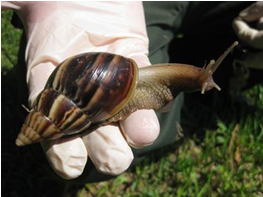
Facts about the Giant African land snail:
- one of the largest land snails in the world: up to 8" long, 4" in diameter
- lives up to 9 years
- contains both female and male reproductive organs
- can produce 100 to 400 eggs at a time and lay 1200 eggs/year
- originally from East Africa
- spread throughout area of Indian and Pacific Oceans to Hawaii and now, the Caribbean
Last month, FDACS found a population of Giant African land snails Achatina fulica in Miami-Dade County. This is one of the most damaging snails in the world because it consumes at least 500 different types of plants, can cause structural damage to plaster and stucco, and can carry a parasitic nematode that can lead to meningitis in humans.
The last reported outbreak and eradication of the Giant African land snail in Florida occurred in 1966 when a boy smuggled three Giant African land snails into Miami as pets. The boy’s grandmother released the snails into her garden and seven years later, more than 18,000 snails were found costing more than $1 million and taking an additional 10 years to successfully eradicate this pest from Florida. This is the only known successful giant African land snail eradication program. Giant African land snails are illegal to import without a permit andno permits have been issued.
To preserve the snail, use gloves to put it in a zip lock bag. Seal the bag and place it in a bucket or plastic container. NEVER release or give these samples away. Please call 888-397-1517 if one is spotted or believed spotted! For more information on invasive snail species, visit: www.freshfromflorida.com. (Photo Credit: Andrew Derksen, Florida Cooperative Pest Survey Program)
[top]
The No-Hurricane Year
A comment for the SART Sentinel by Florida State Meteorologist Amy Godsey
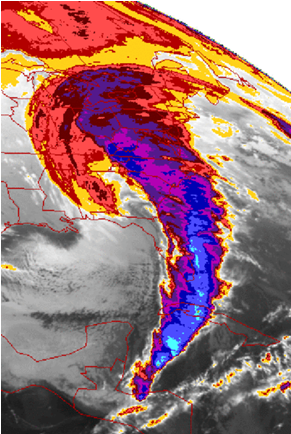
Offbeat Storm at Offbeat Time
The "Storm of the Century"
March 12-15, 1993
In US & Canada
270 people die; another 48 are lost at sea
The Coast Guard rescues 160 people at sea
One freighter sinks in Gulf of Mexico
200 hikers rescued in Appalachians
Every major airport on the East Coast closed
Record snowfall in the Northeast
Total damage is $6 billion, the 4th costliest storm in U.S. History
In Florida
15 tornadoes reported
12-foot storm surge brings death toll to 44
6 inches of snow in the Panhandle
In Canada
Winds gust as high as 131 mph
Nova Scotia: 65-foot wave sinks a ship, 33 drown
New Brunswick: temperatures drop 45 degrees in 18 hours
One reason for the strength and dedication of the responder community in Florida is the strength of the threat, primarily disastrous hurricanes. Historically speaking, the greatest number of storms hit us in September (160 recorded), followed by October (117) and August (97). With so few storm events recently, the Sentiel asked meteorologist Amy Godsey, State Meteorologist at Florida Division of Emergency Management, if this was a temporary or permanent change.
“We typically see a few tropical storms make landfall in Florida each year,” Godsey said, and so this is unusual. Other than flooding and wind damage of course, these storms bring Florida the rainfall it needs to replenish the Floridan aquifer. That we haven’t had a storm this year is certainly quite rare.
“It’s important to keep in mind however that it is just October and while we may have passed the traditional peak of hurricane season, we have a month or so to go. October can be very productive of cyclonic events.
“What is most crucial for responders to keep in mind perhaps is that this time of year we don’t always get the seven to ten days warning of a storm’s approach. Sometimes we don’t get to see storms form over Africa and slowly build in intensity and grind their way across the Atlantic Ocean toward North America. This late in the season storms tend to form much closer to the U.S. mainland, so warnings may only be two to three days instead of a week or more.
“The Caribbean is still very active. The waters of the Gulf of Mexico and the South Atlantic are warm so October can still be a productive month for cyclones. Responders mustn’t let their guard down just yet.”
Godsey, who has been with FDEM since her graduation from Florida State University in June, 2006, explained that meteorological records and satellite imagery suggested that La Niña weather patterns were primarily responsible for tropical storm formation, intensity and movement in the Atlantic. This, she said, tended to be cyclical – balanced often with the opposite phenomenon called El Niño – and could be studied in depth at the NOAA site http://www.elnino.noaa.gov/lanina.html. (Of great interest on that page is the link to U.S. Threat Assessment from the Climate Prediction Center.)
[top]
News & Noteworthy
Advisory Board Meeting Minutes
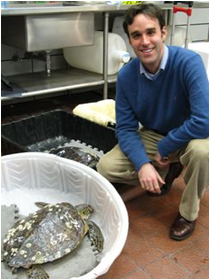
SART Planner Michael Turner attended his final SART Advisory Board Meeting. Turner left FDACS on September 23rd to work with Booz, Allen, Hamilton Consulting in Washington, DC. Sue Rantuccio is currently taking on some of Turner's work load. "Good bye and good luck, Michael," The Editors.
The minutes of the September 21st SART Advisory Board meeting at the Farm Bureau Federation building in Gainesville are available on line now at www.flsart.org/jsp/member
/OperationsMeetingMinutes.jsp. Highlights were:
- Melinda Springer, USDA/APHIS/VS, presented information about Mobile Information Management or MIM animal tracking systems technology.
- Eric Rubenstein, UF/IFAS graduate student, reported on developing SART courses: Small Animal Sheltering, an 8-hour introductory or “Awareness Level” course, and Large Animal Technical Rescue, a 2-day responder or “Operations Level” course.
- Mel Stephens, USDA/APHIS/VS, discussed the Alabama tornadoes of April 2011 and how emergency response was coordinated, especially when twisters tore apart poultry farms.
- Kendra Stauffer, USDA/APHIS/VS, discussed the recent Miami-Dade Airport exercise.
- SART was recently informed that the two courses mentioned above – Small Animal Sheltering and Large Animal Technical Rescue – have been approved by the state and forwarded to DHS for national certification. More information to come!
Bovine Exercise

FDACS and county emergency management staff from Polk, Hillsborough and Manatee Counties are planning a disaster exercise for December 5-6 at the Polk County Extension Office, Bartow. According to Florida ESF-17 Joe Kight, the scenario begins with a “terrorist-driven chemical issue” that affects herds of large animals. Emergency managers and on-the-ground responders will meet for discussion and on-site planning on the 5th and conduct the exercise on the 6th.
According to Census.gov, Florida’s 2010 cattle census was an astonishing 92.6 million animals representing a total value of $78.2 billion! (These numbers exclude sheep/lambs and hogs/pigs.)

FDACS Course in Pensacola, October 25
Course: PER 259 – Sharing Information and Intelligence Related to Food Importation and Transportation
Date: Tuesday, October 25
Place: Escambia County Public Safety Facility, 6575 "W" Street, Pensacola, FL 32505
Cost: Free
Description: A one-day course designed to prepare participants to utilize and implement effective sharing of information and intelligence to enhance food safety and security related to food importation and transportation.
Target Students: Law Enforcement, state Fusion Center personnel, emergency managers and responders, Extension, public health, food and agriculture professionals, transportation industry, and federal, state, local, tribal and regional officials.
Registration and Information: http://flsart.org/mgtcourses/
Questions or comments: John Burkette, Office of Agricultural Law Enforcement, Emergency Preparedness Section, FDACS john.burkette@freshfromflorida.com (850) 245-1387
The Florida Department of Agriculture and Consumer Services is collaborating with the Center for Agriculture and Food Security and Preparedness at the University of Tennessee-College of Veterinary Medicine, the University of Florida-Institute for Food and Agricultural Sciences and the Regional Domestic Security Task Forces to offer Department of Homeland Security (DHS) certified courses in Florida. Courses are open to all U.S. citizens, and are free of charge through DHS grant funding.

PetSmart Charities Presents Webinars
Pam Burns of Florida SARC passed along information about the PetSmart Charities webinars, a four-part series titled “Disaster Preparedness 101.” For specific webinar dates/times and to register visit http://petsmartcharities.webex.com.
Part 1: Protecting Your Rescue Animals from Disaster – It Takes Pre-planning and Preparedness (Presented by Karen Brown, Program Director, RedRover)
Part 2: How to Set Up and Manage a Collocated Emergency Animal Shelter (Presented by Tracy Reis Program Manager-Emergency Services, American Humane and Diane Robinson, Emergency Services Training Manager, American Humane)
Part 3: Best Practices and Lessons Learned from the Joplin Tornado – May 2011 (Presented by Tim Rickey, Senior Director, Field Investigations & Response, Anti-Cruelty Group, ASPCA)
Part 4: Understanding Your Key Role in Managing Animal Issues When Your Community is Affected by Disaster (Presented by Tim Rickey, Senior Director, Field Investigations & Response, Anti-Cruelty Group, ASPCA)

SART Web Site Proving Popular
According to Jiannong Xin, UF/IFAS, the redesigned Florida SART web site is a popular destination for lots of web surfers. His report is attached here as a pdf file. Which of the following numbers would you guess was closest to the yearly average of hits: 10,000 – 500,000 – 2,000,000.

U.S. Government Accountability Office Reports
“Challenges for the Food and Agriculture Sector in Responding to Potential Terrorist Attacks and Natural Disasters” – The 12-page statement of Lisa Shames, Director, Natural Resources and Environment is GAO-11-946T. Released September 13, 2011 it is available on line at http://www.gao.gov/new.items/d11946t.pdf. Shames can be reached at (202) 512-3841 or shamesl@gao.gov.
Significant items from Shames’ testimony include:
- “Our prior work has shown that roles and responsibilities must be clearly defined and understood to facilitate rapid and effective decision making.3 This issue has yet to be resolved.”
- “In 2009, we testified before this Subcommittee that the lack of a government-wide initiative to address current and future veterinarian shortages may place human health, the economy, and the nation’s food supply at risk…steps are still necessary to understand the veterinarian workforce needed during a potential catastrophic event—whether a pandemic or an attack on the food supply.”
Shames also made three key points. “First, there is no centralized coordination to oversee federal agencies’ overall progress in implementing the nation’s food and agriculture defense policy. Second, USDA does not have a strategy for implementing its HSPD-9* responsibilities and faces challenges implementing these responsibilities. Third, USDA faces challenges in coordinating the federal food and agriculture response for natural disasters for which ESF-11 was activated.”
* HSPD-9 “Defense of United States Agriculture and Food” http://www.fas.org/irp/offdocs/nspd/hspd-9.html
** Also see http://www.gao.gov/products/GAO-11-652 which is the August 19, 2011 report titled ‘Homeland Security: Actions Needed to Improve Response to Potential Terrorist Attacks and Natural Disasters Affecting Food and Agriculture”

New Web Site Available – http://theshelterpetproject.org/
“The Shelter Pet Project, launched in 2009, is a public service ad campaign focused on spreading the word that pets in shelters are wonderful and lovable, and encouraging potential adopters to consider the shelter as the first place to look when acquiring a ‘new best friend.’
“The Shelter Pet Project is the result of a collaborative effort between two leading animal welfare groups, The Humane Society of the United States and Maddie’s Fund, and the leading producer of public service advertising (PSA) campaigns, The Ad Council. Our goal is to make shelters the first place potential adopters turn when looking to get a new pet, ensuring that all healthy and treatable pets find loving homes. We do this by breaking down misconceptions surrounding shelter pets and communicating that ‘A person is the best thing to happen to a shelter pet. Be that person. Adopt.’”
Editor’s Note: If you have five minutes, go to the advertising information page of The Shelter Pet Project - http://theshelterpetproject.org/who-we-are/our-campaign - and watch a few of their commercials. Some are hilarious. All are thoughtful.
Watch for coming announcements about “webinars” sponsored through Maddie’s Institute http://www.maddiesfund.org/. The first of what the Institute expects will be a series was presented on Thursday evening, October 6. Dr. Brian DiGangi, DVM, Clinical Assistant Professor of Shelter Medicine at the University of Florida College of Veterinary Medicine, spoke about how decisions made in the first hour in the shelter can impact the stress response and susceptibility to disease of dogs and cats.
[top]
About the SART Sentinel |
The SART Sentinel is an e-mail newsletter prepared monthly by the members of the Florida State Agricultural Response Team. Past issues of the Sentinel are archived on the Florida SART Web Site www.flsart.org. If you have a story or photo that you would like to have considered for publication in the SART Sentinel, please contact the editors. Editor: Rick Sapp, PhD, Technical Writer under contract with the Florida Department of Agriculture & Consumer Services, Division of Animal Industry rsa5@cox.net. Associate Editor: Joe Kight, State ESF-17 Coordinator, Florida Department of Agriculture & Consumer Services, Division of Animal Industry Joe.Kight@freshfromflorida.com [top] |
|
|
